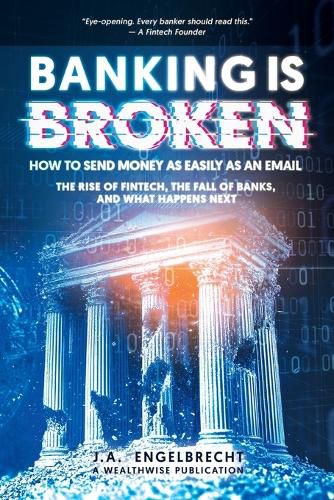Readings Newsletter
Become a Readings Member to make your shopping experience even easier.
Sign in or sign up for free!
You’re not far away from qualifying for FREE standard shipping within Australia
You’ve qualified for FREE standard shipping within Australia
The cart is loading…






This title is printed to order. This book may have been self-published. If so, we cannot guarantee the quality of the content. In the main most books will have gone through the editing process however some may not. We therefore suggest that you be aware of this before ordering this book. If in doubt check either the author or publisher’s details as we are unable to accept any returns unless they are faulty. Please contact us if you have any questions.
In a world where information moves instantly, why is it still so slow-and so expensive-to send money across borders?
Banking is Broken: Money Should Move Like an Email in the 21st Century takes you inside the global banking system, explaining how it works, why certain inefficiencies persist, and why cash is far from disappearing. It's not just a critique-it's a guided tour of the structures, habits, and business models that define how money moves today.
You'll learn:
Why cash remains a dominant payment method in many parts of the world, despite the rise of digital alternatives. How different banking models operate, from prefunded accounts that speed up settlement to kiosk banking that extends services into underserved areas. The hidden complexities and costs behind cross-border remittances-and why, even in 2025, they can take days and consume hefty fees. The interplay between traditional banks, payment processors, and new fintech entrants, and why progress is slower than technology allows. How regulation, legacy infrastructure, and risk controls shape the pace and cost of global transactions.
Through real-world examples and clear explanations, the book uncovers the mechanics of SWIFT, correspondent banking, and other settlement systems that underpin international transfers. You'll see why "instant" often means "hours or days" once money crosses borders, and how these delays impact families, businesses, and entire economies.
It also explores emerging solutions: blockchain-enabled settlement, digital identity integration, and more efficient remittance networks. But it doesn't shy away from the reality that widespread change will take time-and that cash, with all its tangible reliability, will remain an important part of the mix for years to come.
Whether you're a policymaker, entrepreneur, or curious consumer, Banking is Broken will give you a deeper understanding of how money really moves, why it often doesn't move fast enough, and what needs to change to make 21st-century payments match the speed of the modern world.
If you've ever wondered why sending a photo overseas is free and instant, but sending your own money is slow and costly, this book will make it clear-and make you see the financial system in a new light.
$9.00 standard shipping within Australia
FREE standard shipping within Australia for orders over $100.00
Express & International shipping calculated at checkout
This title is printed to order. This book may have been self-published. If so, we cannot guarantee the quality of the content. In the main most books will have gone through the editing process however some may not. We therefore suggest that you be aware of this before ordering this book. If in doubt check either the author or publisher’s details as we are unable to accept any returns unless they are faulty. Please contact us if you have any questions.
In a world where information moves instantly, why is it still so slow-and so expensive-to send money across borders?
Banking is Broken: Money Should Move Like an Email in the 21st Century takes you inside the global banking system, explaining how it works, why certain inefficiencies persist, and why cash is far from disappearing. It's not just a critique-it's a guided tour of the structures, habits, and business models that define how money moves today.
You'll learn:
Why cash remains a dominant payment method in many parts of the world, despite the rise of digital alternatives. How different banking models operate, from prefunded accounts that speed up settlement to kiosk banking that extends services into underserved areas. The hidden complexities and costs behind cross-border remittances-and why, even in 2025, they can take days and consume hefty fees. The interplay between traditional banks, payment processors, and new fintech entrants, and why progress is slower than technology allows. How regulation, legacy infrastructure, and risk controls shape the pace and cost of global transactions.
Through real-world examples and clear explanations, the book uncovers the mechanics of SWIFT, correspondent banking, and other settlement systems that underpin international transfers. You'll see why "instant" often means "hours or days" once money crosses borders, and how these delays impact families, businesses, and entire economies.
It also explores emerging solutions: blockchain-enabled settlement, digital identity integration, and more efficient remittance networks. But it doesn't shy away from the reality that widespread change will take time-and that cash, with all its tangible reliability, will remain an important part of the mix for years to come.
Whether you're a policymaker, entrepreneur, or curious consumer, Banking is Broken will give you a deeper understanding of how money really moves, why it often doesn't move fast enough, and what needs to change to make 21st-century payments match the speed of the modern world.
If you've ever wondered why sending a photo overseas is free and instant, but sending your own money is slow and costly, this book will make it clear-and make you see the financial system in a new light.